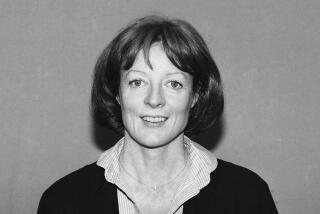An Unrevealing Portrait of a Reticent Personality
- Share via
In the Hollywood where a teenage Angela Lansbury began working during World War II, the MGM dressing rooms were a cache of tabloid-quality secrets. Marlene Dietrich habitually strolled around with her robe open and “nothing on underneath.” Dancer Ann Miller and singer Nanette Fabray “both had to get rubber noses, because their real noses had been botched during plastic surgery.”
But nothing remotely so dishy about Lansbury emerges in this biography by theater critic Martin Gottfried, who has also done lives of Bob Fosse, Stephen Sondheim, Danny Kaye and George Burns. Lansbury’s British reticence wouldn’t allow it. And, Gottfried argues, there’s not much to tell about her that would interest tabloids or their readers. Her public life--from her nomination for a supporting actress Oscar for “Gaslight” when she was 17 to her Broadway triumph in “Mame” in her 40s to TV stardom in “Murder, She Wrote”--is the one that matters.
“It was all gift,” Lansbury says of her acting ability. “Not hard work. You are born with it. Absolutely.” But the management of that ability over a half-century did take hard work, a disciplined lifestyle, shrewd choices and luck, all of which she displayed, Gottfried says. After a brief first marriage to actor Richard Cromwell (who was gay and trying to convince himself otherwise), Lansbury settled into an enduring union with Peter Shaw, who was also British, also reticent and a success in his own right as an agent and studio executive. They bought houses, had children, were productive and happy.
As is often the case with biographies, the early chapters are the most interesting. Lansbury’s grandfather George, a pacifist orator and Labor Party leader, was a great name in English politics between the wars. Her mother, Moyna Macgill, was a noted stage actress. Her father ran a company that supplied wood veneers for the Queen Mary liner. Her sister Isolde married Peter Ustinov. Through Depression privations--her father died young--and wartime immigration to America, Lansbury’s family remained close and her life stimulating, Gottfried says. She became precociously mature.
To help her widowed mother, Lansbury says, “I just always had to be a responsible person. Who could be there on time. Who could be relied upon. Who could deliver the goods”--as she proceeded to do in the domestic sphere and on stage and in film, Gottfried says, ever since 1943, when MGM chief Louis B. Mayer, watching a batch of screen tests, “turned to his assistant and said tersely, ‘Sign that girl.’ ”
So thoroughly does Gottfried concentrate on Lansbury’s professional life that in the later chapters, the bits of her private life that do gain entry to the narrative seem out of place, like surplus guests at a cocktail party shifting from foot to foot, balancing their drinks on their napkins, wondering why they’ve come.
During an account of one of her London stage runs, for example, Lansbury is abruptly quoted about the inevitability of romances among cast members, the amount of promiscuity even ordinary folks indulge in and the opportunities available to her husband back in Hollywood. Did either have an affair? Neither she nor Gottfried is telling. So why bring it up?
Also, it seems, before a firestorm destroyed her Malibu house in 1970 and she moved her family to Ireland, Lansbury’s teenage children “got into hard drugs” and caused her and Shaw much concern, but we don’t hear about it at the time it happened--only when Lansbury is reacting in dismay to questioning by Barbara Walters on a TV special in 1985.
The real story, Gottfried insists, is the evolution of her acting. Long stuck in movie character roles--as older, often petulant women, like Laurence Harvey’s mother in “The Manchurian Candidate”--she gained the confidence to become a leading lady only on Broadway. Not a trained dancer or a naturally powerful singer, she came to excel at both. On stage in “Sweeney Todd,” she reached her pinnacle as a character actress; then, as Jessica Fletcher in “Murder, She Wrote,” she won vast audiences by playing herself, as true stars do.
An “American icon,” Gottfried calls her--but also a person we don’t know much better when we finish this book than when we began.
More to Read
Sign up for our Book Club newsletter
Get the latest news, events and more from the Los Angeles Times Book Club, and help us get L.A. reading and talking.
You may occasionally receive promotional content from the Los Angeles Times.








